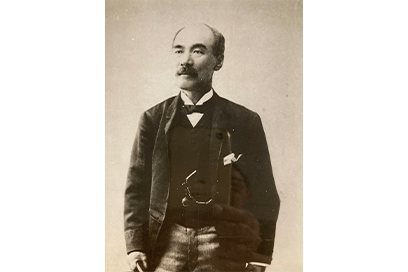
Introduction Origins
1922
Introduction: Origins
O.S.K. Lines, Ltd. solidifies its position as a major Japanese shipper.
The birth of O.S.K. Lines, Ltd. in Osaka, the heartland of Japanese marine shipping, was the culmination of numerous events that took place after the Meiji Restoration.
That development, which expanded the nation’s domestic and international shipping routes, led to the establishment of Osaka Building Co., Ltd.
1. The Establishment of O.S.K. Lines, Ltd.
Osaka was originally the hub for Japanese shipping, as evidenced by the fact that the Kitamaebune shipping route connecting Hokkaido (formerly called Ezo) to the Sea of Japan originated at Osaka. Although commoners were allowed to own ships after the Meiji Restoration, it was mainly Western shipping companies that took control of shipping in Japan. Foreign trading companies that had expanded to Japan controlled both coastal routes and ocean routes, and steamers owned by those companies were used to transport cargo along the Seto Inland Sea and Kyushu routes. Naturally, the government could not just ignore this situation. They opened up the Osaka–Yokohama route using steamships purchased from abroad, but this route was mainly used for official purposes, and shipping in Japan, for all intents and purposes, was exclusively the domain of foreign trading companies.
-

Saihei Hirose
This situation changed with the outbreak of the Satsuma Rebellion in 1877. Supplies and troops needed for the war had to be transported to Kyushu, but the number of vessels was limited, so a growing number of companies entered the shipping business. However, this left an overabundance of vessels when the war ended, so competition between steamship companies intensified. In particular, competition for customers in the form of fare reductions grew more apparent.
The Osaka Shipping Company was formed in 1881 by parties that were concerned about the negative effects of this competition, and an agreement on shipping rates was established at that time. However, competition failed to subside following those developments, and shipping companies realized that corporate mergers were the only remaining option. As a result, a major shipping company was established. The man responsible for this transition was Masahatsu Nakahara, the president of the Alliance Shipping Company, the company that had taken over the business operations of the Osaka Shipping Company. Nakahara sought the cooperation of Saihei Hirose, the head of Sumitomo Zaibatsu. Hirose, who had devoted himself not only to the Sumitomo family but also to the development of the Kansai business community, accepted the proposal from a broad perspective and instructed his nephew Teigo Iba, who later would become the second head of Sumitomo, to assist with the establishment of the company.
Coordinating the complex interests involved was no easy task, but O.S.K. Lines (now called Mitsui O.S.K. Lines), which would play a central role in the establishment of Daibiru Corporation (hereinafter, “Daibiru”), began operating in May 1884 at 14 Tomijima-cho, Kita-ku, Osaka (its present-day address is 3-7-25 Kawaguchi, Nishi-ku, Osaka). The company was capitalized at 1.2 million yen and owned 93 ships. Hirose was appointed president.
-
1923 1944 Beginnings
-
Section 2. Launching a Building Management Business
-
Section 4. Business Development in Wartime
-
1945 1957 Reconstruction
-
Section 2. Our Buildings Reopen
-
1958 1988 Development
-
Section 1. Expanding the Building Management Business
- 1. The End of the Requisition of the Hibiya Daibiru Buildings
- 2. Upgrading the Facilities of the Daibiru Buildings and Damage Caused by the 2nd Muroto Typhoon
- 3. The Completion of the North Wing of the Shin-Daibiru Building
- 4. The Completion of the Yaesu Daibiru Building
- 5. The Acquisition of the Midosuji Daibiru Building
- 6. The Completion of the Kojimachi Daibiru Building
- 7. The Completion of the Uchisaiwaicho Daibiru Building
- 8. The Completion of the Dojima Daibiru Building
- 9. The Completion of the Awajimachi Daibiru Building
- 10. The Completion of the Mita-Nitto Daibiru Building
-
Section 2. Expanding the Business Through M&A
-
-
1989 2003 Expansion (1989–2003)
-
Section 1. Creating New Urban Spaces
- 1. The Bubble Economy and Daibiru
- 2. The Hibiya Daibiru Rebuilding Project
- 3. The Completion of the Rebuild
- 4. The Start and Execution of Renovation Plans
- 5. The Completion of the Kita-Umeda Daibiru Building
- 6. The Completion of the Yodoyabashi Daibiru Building
- 7. The Completion of the Estate Tosabori Building
- 8. The Completion of the Umeda Daibiru Building
- 9. The Completion of Violette Takarazuka
- 10. The Shinjuku Daibiru Building and Shiba Daibiru Building Acquisitions
-
Section 2. The Development of a New Corporate Identity and a Name Change
-
Section 3. Disaster Preparedness and Risk Management
-
-
2004 2023 Transformation (2004–2023)
-
Section 1. Becoming a Consolidated Subsidiary of Mitsui O.S.K. Lines and Promoting Management Plans
- 1. Becoming a Consolidated Subsidiary of Mitsui O.S.K. Lines
- 2. Concentrating Investment in the Tokyo Area
- 3. Expanding into Other Countries and Japanese Regions
- 4. Establishing Daibiru 3D-Project Phase I, a Medium-Term Management Plan
- 5. Establishing Our Management Philosophy and Mission Statement
- 6. Establishing Daibiru-3D Project Phase II, a New Medium-Term Management Plan
- 7. Ongoing Establishment of New Medium-Term Management Plans
-
Section 2. Expanding Our Business
- 1. The Akihabara Station Redevelopment Project and the Completion of the Akihabara Daibiru Building
- 2. The Acquisition of the Toranomon Daibiru Building
- 3. The 3 Nakanoshima Joint Development Project and the Completion of the Nakanoshima Daibiru Building
- 4. The Completion of the Tosabori Daibiru Building
- 5. The Acquisition of Aoyama Rise Square
- 6. The 3 Nakanoshima Joint Development Project and the Completion of the Daibiru-Honkan Building
- 7. Rebuilding the Shin-Daibiru Building
- 8. Renovation Work
- 9. Multiple Awards
- 10. Delving into Commercial Facilities
- 11. Acquiring a Partial Interest in the Seavans South Building
- 12. Expansion to Sapporo
- 13. Selling Seven Residential Properties
- 14. Starting the Rebuild of the Midosuji Daibiru Building
- 15. Starting the Rebuild of the Yaesu Daibiru Building
-
Section 3. Overseas Business Expansion
-
Section 4. Further Strengthening of the Corporate Structure and Group Reorganization
-
Section 5. Harmonious Coexistence with Society
- 1. Developing a Compliance System
- 2. Developing an Internal Control System
- 3. Risk Management Measures
- 4. Sustainability Initiatives
- 5. Social Contribution and Cultural Support Initiatives
- 6. Environmental Initiatives
- 7. Working Style Reform Initiatives
- 8. Launching the Brand Development Project
- 9. Launching the Head Office Renovation Project
-
Section 6. Toward Our 100th Anniversary and Beyond
- 1. Becoming a Full Subsidiary of Mitsui O.S.K. Lines
- 2. Acquiring a Partial Interest in Otemachi First Square
- 3. Acquiring a Partial Interest in the Otemon Tower / ENEOS Building
- 4. Investment in an SPC for Logistics Facilities in the Nishinomiya Area
- 5. Project Participation in the United States
- 6. Project Development in Melbourne, Australia
- 7. Formulation of a New Medium- and Long-Term Management Plan
- 8. Implementing 100th Anniversary Projects
- 9. For Future Generations
-
